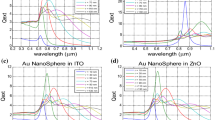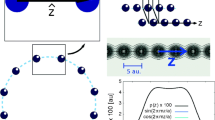Noble metals are commonly used as plasmon materials because of their high density of free electrons, but semiconductor materials are also becoming of interesting in this field because its electron density can be varied by doping. Metal nitrides can be an alternative to noble metals because of their low absorption loss and high electron density. Among others, TiN and ZrN seem to be most suitable as alternative plasmonic materials because their optical properties are dominated by conduction electrons near the plasmon frequency. There is the flame spray pyrolysis process, which is currently developed to produce such kind of nanoparticles. In this paper, based on an extension of the discrete sources method, the effect of the hydrodynamic Drude model of the quantum nonlocal effect on the optical characteristics of semiconductor nanoparticles is analyzed. The influence of accounting for the nonlocal effect (NLE) on the optical properties under spherical particles deformation has been investigated. It has been shown that accounting for the NLE leads to a plasmon resonance blue shift and a damping similar to noble metals. It was found that smaller particles demonstrate larger NLE influence than larger ones. Besides, the influence of polarization on the local and nonlocal responses of 3D nonspherical semiconductor particles has been investigated as well. Using simulation accounting for the nonlocal effect, it is shown that the extinction of a nonspherical ZrN particles exceeds that of a gold particle.
Similar content being viewed by others
References
A. Trügler, Optical Properties of Metallic Nanoparticles, Springer International Publishing, Switzerland (2016).
S. Maier, Plasmonics: Fundamentals and Applications, Springer, New York (2007).
H. Atwater, “The promise of plasmonics,” Sci. Am., 296, 56–62 (2007).
G. Naik, V. Shalaev, and A. Boltasseva, “Alternative plasmonic materials: Beyond gold and silver,” Adv. Mater., 25, 3264–3294 (2013).
S. Fan, “Photovoltaics: An alternative ‘Sun’ for solar cells,” Nature Nanotechnol., 9, 92–93 (2014).
U. Guler, V. Shalaev, and A. Boltasseva, “Nanoparticle plasmonics: going practical with transition metal nitrides,” Mater. Today, 18, No. 4, 227–237 (2015).
A. Comin and L. M. L., “New materials for tunable plasmonic colloidal nanocrystals,” Chem. Soc. Rev., 43, 3957–3975 (2014).
Y. Zhong, S. Malagari, T. Hamilton, and D. Wasserman, “Review of mid-infrared plasmonic materials,” J. Nanophotonics, 9, 093791 (2015).
A. Agrawal, S. H. Cho, O. Zandi, and et al., “Localized surface plasmon resonance in semiconductor nanocrystals.” Chem. Rev., 118, 3121–3207 (2018).
U. Kortshagen, R. Sankaran, R. Pereira, and et al., “Nonthermal plasma synthesis of nanocrystals: Fundamental principles, materials, and applications,” Chem. Rev., 116, 18, 11061–11127 (2016).
P. Patsalas, N. Kalfagiannis, S. Kassavetis, G. Abadias, D. Bellas, C. Lekka, and E. Lidorikis, “Conductive nitrides: Growth principles, optical and electronic properties, and their perspectives in photonics and plasmonics,” Mater. Sci. and Eng. R., 123, 1–55 (2018).
M. Kumar, S. Ishii, N. Umezawa, and T. N. T., “Band engineering of ternary metal nitride system Ti1-x ZrxN for plasmonic applications,” Opt. Mater. Express, 6, 1, 29–38 (2016).
A. Boltasseva and H. Atwater, “Low-loss plasmonic metamaterials,” Science, 331, 6015, 290–291 (2011).
G. Naik., J. Schroeder, X. Ni, and et al., “Titanium nitride as a plasmonic material for visible and near-infrared wavelengths,” Opt. Materials Express, 2, No. 4, 478–489 (2012).
W. Y. Teoh, R. Amal, and L. Mädler, “Flame spray pyrolysis: An enabling technology for nanoparticles design and fabrication,” Nanoscale, 2, 1324–1347 (2010).
M. Mendes, A. Luque, I. Tobias, and A. Marti, “Plasmonic light enhancement in the near-field of metallic nanospheroids for application in intermediate band solar cells,” Appl. Phys. Lett., 95, 071105 (2009).
A. Lalisse, G. Tessier, J. Plain, and G. Baffou, “Plasmonic efficiencies of nanoparticles made of metal nitrides (TiN, ZrN) compared with gold,” Sci. Rep., 6, N38647 (2016).
C. David and F. G. de Abajo, “Spatial nonlocality in the optical response of metal nanoparticles,” J. Phys. Chem. C., 115, 19470–19475 (2011).
S. Raza, S. Bozhevolnyi, M. Wubs, and N. Mortensen, “Nonlocal optical response in metallic nanostructures. Topical Review,” J. Phys.: Condens. Matter, 27, 3204–3300 (2015).
M. Wubs and A. Mortensen, “Nonlocal response in plasmonic nanostructures. Quantum plasmonics,” in: Quantum Plasmonics, S. Bozhevolnyi, et al., Eds., Springer, Switzerland (2017), pp. 279–302.
J. R. Maack, N. A. Mortensen, and M. Wubs, “Size-dependent nonlocal effects in plasmonic semiconductor particles,” Europhys. Lett., 119, No. 1, 17003 (2017).
Y. Eremin, A. Doicu, and T. Wriedt, “Discrete sources method for modeling the nonlocal optical response of a nonspherical particle dimer,” J. Quantit. Spectrosc. and Radiat. Transfer, 217, 35–44 (2018).
Y. Eremin, T. Wriedt, and W. Hergert, “Analysis of the scattering properties of 3D non-spherical plasmonic nanoparticles accounting for nonlocal effects,” J. of Mod. Optics, 65, No. 15, 1778–1786 (2018).
A. Doicu, Y. Eremin, and T. Wriedt, Acoustic and Electromagnetic Scattering Analysis Using Discrete Sources, Academic Press, Boston (2000).
N. Bahvalov, Numerical Methods: Analysis, Algebra, Ordinary Differential Equations, Mir, Moscow (1977).
C. Colton and R. Kress, Integral Equation Methods in Scattering Theory, John Wiley & Sons, New York (1983).
R. Newton, “Optical theorem and beyond,” Am. J. Phys., 44, No. 7, 639–642 (1976).
P. B. Johnson and R. Christy, “Optical constants of the noble metals.” Phys. Rev. B, 6, 4370–4379 (1972).
P. Patsalas and N. K. S. Kassavetis, “Optical properties and plasmonic performance of titanium nitride. Review,” Materials, 8, 3128–3154 (2015).
Author information
Authors and Affiliations
Corresponding author
Rights and permissions
About this article
Cite this article
Eremin, Y.A., Mädler, L. & Wriedt, T. Influence of the Nonlocal Effect on the Optical Properties of Nonspherical Plasmonic Semiconductor Nanoparticles. Comput Math Model 31, 58–74 (2020). https://doi.org/10.1007/s10598-020-09476-w
Published:
Issue Date:
DOI: https://doi.org/10.1007/s10598-020-09476-w




